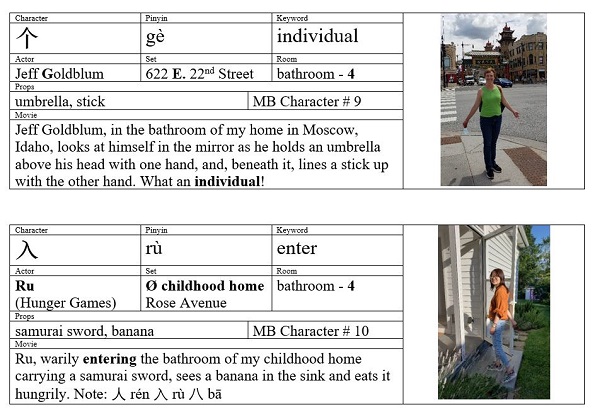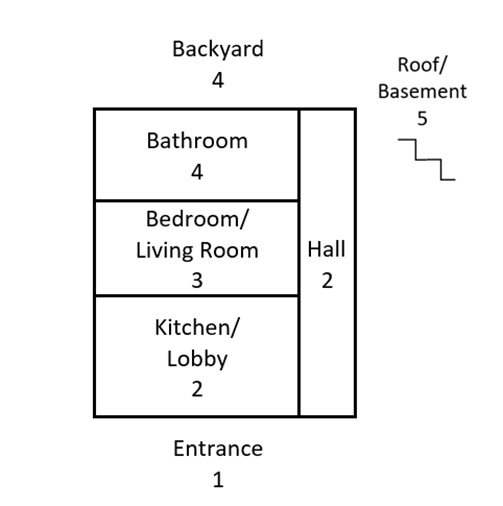Mandarin Blueprint‘s founders, Luke Neale and Phil Crimmins, have invented a systematic, comprehensive, research-informed method for learning Mandarin Chinese. In an innovative application of the method of loci – a memory strategy attributed to the ancient Greeks and Romans – Mandarin Blueprint users are taught to learn Chinese characters by envisioning places from their own histories, then imagining actors interacting with props in rooms within those locations. Through this creative process, the Chinese character’s pronunciation, meaning, reading and writing are all conveyed. The founders term their invention the “Hanzi Movie Method” and report it has cleared the second stage of the U.S. patenting process.

Reviewing Chinese characters with Mandarin Blueprint’s method is augmented with spaced repetition software (SRS) to replace printed flashcards. Mandarin Blueprint’s current choice of SRS is Anki. Mandarin Blueprint is developing its own proprietary SRS and is expecting to beta test it in July, 2021.
I used Anki effectively until I was unable to adjust the settings to limit the number of cards per review session. When I ended up with 800+ cards to review per day, a multi-hour task, I stopped reviewing cards.
Hopeful, however, that I might some day figure out Anki, I continued to use Mandarin Blueprint’s Hanzi Movie Method to create Anki cards for each character. I just never saw the cards again. (I also tried creating a list of flashcards in Skritter but, without prompts to help me remember my custom movie scenes, I found the task tedious, began to dread doing it, then quit.)
Simply through using the Mandarin Blueprint method – with no review at all – I learned to recognize about 100 characters before the forgetting curve overtook me. The lack of review cost me the ability to remember the characters well enough to read simple demo sentences.
I am a true fan of Mandarin Blueprint. I have written about the positive trajectory of my progress after beginning to use its method. I bought the full bundle of Mandarin Blueprint courses through Level 57 and happily contributed at the access level to the crowdfunding campaign to develop the Advanced Course.
I began to ponder. Making the cards in Anki worked pretty well for learning about 100 characters. I just needed to see those cards again to make the characters stick. I needed a low-tech, paper-and-pen alternative to Anki.
I used Microsoft Word to make a Hanzi Move Method data collection form to use as a printable flashcard.
Here is a .pdf of a blank data collection form (opens in a new tab), plus my imagining of a “Tone House” that helps me logically remember which tone goes with which room using the method of loci (also termed “memory palace“). The .pdf includes a list of the first four characters which are simple enough not to require individual cards. (The image accompanying this article depicts the “method of loci” well.)
Here is a .pdf of sample flashcards (opens in a new tab). They include my versions of settings, actors, props, and scenes using the Hanzi Movie Method for characters #5 – #12. As you can see, the fields are not fixed so I can write as little or as much as I want. If I can already sight read a character, I don’t make a card. The goal, of course, is to not make cards, but to learn characters in order to read!
Although Mandarin Blueprint suggests including images for compound words, I’ve included an image field for single characters if needed. For example, I’ve had trouble remembering how to write the top portions of 人 rén, 入 rù, and 八 bā and added images to these cards to try to help myself.
For this post, I created custom images for my sample flash cards to publish online since I don’t hold rights to other images. But I follow Mandarin Blueprint’s method and search the Internet to copy and paste images that speak to me. For example, an image of Snape will always accompany 总是 zǒng shì.
Each character’s flashcard takes 3-5 minutes to imagine then type. The layout is horizontal and I enter one to two cards per page. I print the pages and fold long cards in half horizontally, or use scissors to trim two cards per page into horizontal strips about the same height.
I can review the cards sitting at a desk or lying on the coach. I can spread them on a bed to compare differences in similar characters. I can position the cards to reveal only characters on the left and only English on the right. Flashcards for Levels 1-6 ended up as 24 pages to print.

I am my own spaced repetition algorithm! I sort cards into piles based on how well I know the characters. I review cards in the weak piles first, move them to the strong piles, and so on.
Would using spaced repetition software to review characters be optimal? I’m sure it would. I just couldn’t make current SRS offerings work. I’ve signed up to beta test MB’s forthcoming proprietary flash card software. In the meantime, I’m cranking through characters, heading towards a 1,530-character milestone.
For an introduction to Mandarin Blueprint’s Hanzi Movie Method, I recommend the video on MB’s home page and this YouTube video from the course. Here’s the first entry in a set of articles describing the method.
Why do I encourage people to 1) learn Mandarin Chinese, and 2) try Mandarin Blueprint? I think the state of things in the U.S., plus the state of U.S.-Chinese relations, makes being able to speak each other’s languages an imperative. Time is of the essence. In my earnest quest to learn Mandarin Chinese in my 60s, I’ve spent countless hours researching second language acquisition and thousands of dollars on textbooks, courses, and apps. In my estimation, the most efficient system likely to produce desired outcomes in the shortest amount of time in the most pleasant way is Mandarin Blueprint.
I would love to be part of a local Mandarin Blueprint users’ group that meets in-person in the Blacksburg, Virginia, U.S.A. area. If that interests you or I can be of service in any way, please don’t hesitate to contact me. Added 9/10/21: Several MB users have joined me in the Mandarin Chinese Conversation Groups on Meetup.
I thank paleogeologist and Virginia Tech visiting scholar Tian Gan for helping me create flashcard images.
Views expressed are the author’s own and may not represent Mandarin Blueprint’s positions, strategies or opinions.
Anne Giles, M.A., M.S., L.P.C., is a student of Mandarin Chinese and also a mental health counselor, able to provide counseling services only to residents of the Commonwealth of Virginia, U.S.A. This content is for informational purposes only and is not a substitute for medical or professional advice. Consult a qualified health care professional for personalized medical and professional advice.


Hi such a shame. You can set max reviews etc lots of customization with add-ons too. Ask in the MB forum for help in the anki set up and reviews
Thanks for your feedback, Simon. I would prefer to be using Anki and consulted many sources to try to troubleshoot. My hypothesis is that if I had been able to have coaching in person, I might have been okay. Since that was not to be last year, this is my solution. I am eager to beta test Mandarin Blueprint’s propriety flashcards.